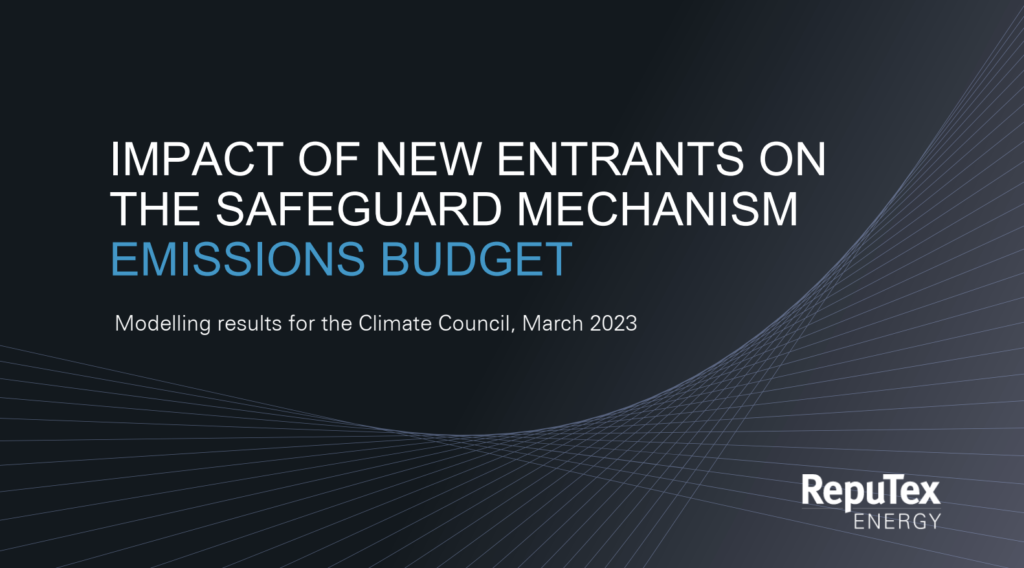Climate Council and the Australian Conservation Foundation engaged RepuTex Energy to model the impact of changes in the production of coal and gas – including the addition of new projects – on the Safeguard Mechanism.
This modelling explores how increases in fossil fuel production and new projects may affect the overall emissions reduction delivered by the Safeguard Mechanism, and the feasibility of meeting – or improving on – Australia’s 2030 emissions reduction target.
Emissions from coal, oil and gas currently make up approximately half of all emissions regulated under the Safeguard Mechanism. Threatening to add to this already large share is a pipeline of potential new coal and gas projects and proposed expansions. These will bring significantly more emissions into the Safeguard Mechanism if they proceed. The amount of fossil fuel production that occurs in coming years will therefore have a significant impact on the success or otherwise of the reformed scheme.
In outlining proposed new settings for the Safeguard Mechanism, the Australian Government has assumed that some new coal and gas projects will enter the scheme in the years to 2030. This would be contrary to expert international advice and scientific evidence about what is needed now to tackle harmful global warming and hold global temperature rise as close as possible to 1.5 degrees. The best way for Australia to ensure the Safeguard Mechanism stays within its carbon budget and contributes to our national emissions reduction effort would be to cease approving new or expanded coal, oil and gas projects.
Climate Council and the Australian Conservation Foundation do not support new or expanded fossil fuel projects proceeding. Rather, we recognise that Australia and the world at large must rapidly accelerate the transition from fossil fuels to clean energy. This modelling takes the government’s proposed policy settings as a basis, but should not be interpreted as an endorsement of those settings. For more information on our detailed recommendations to deliver a stronger Safeguard Mechanism, check out Climate Council’s submission to the Australian Government.
By taking the government’s proposed policy setting as its basis, this modelling illustrates the very real risks and challenges associated with progressing further fossil fuel expansions and new projects – both to the Safeguard Mechanism’s emissions budget and the achievement of Australia’s legislated emissions reduction target.
Report key findings:
- Emissions just from well-advanced new coal and gas projects in the development pipeline would total 56.6 MtCO2-e over the years to 2030 if they proceed. This is more than a quarter of the total emissions reduction proposed to be achieved by the Safeguard Mechanism reforms over the years to 2030 (205 MtCO2-e). This figure would be even higher if more of the projects in the development pipeline were to proceed, and if the analysis were extended beyond 2030. This is because some potential new projects would not be operating at full capacity by 2030 and would therefore have an even higher impact in the following decade.
- Even relatively small changes in the production of coal and gas risk higher emissions blowing the government’s proposed carbon budget for the Safeguard Mechanism. We could overshoot the budget by between 13 and 35 MtCO2-e by 2030 if production is just modestly higher than the government has modelled. That’s equivalent to the annual emissions of between 680,000 and 1.8 million Australians.
- Industries like steel, aluminium and cement are carrying the weight of fossil fuels under the proposed Safeguard Mechanism settings. If fossil fuel production is even modestly higher than the government has projected, this will mean existing participants in other sectors have to do far more. Annual emissions decline rates could need to be as high as 8.9 percent (up from 4.9 percent in the government’s proposal) to compensate for higher fossil fuel emissions and stay under the carbon budget cap.
- If the government made fossil fuel new entrants accountable for all their emissions from day one, this would mean the Safeguard Mechanism could achieve even greater emissions reduction; an additional 30 MtCO2-e. That’s nothing to be sneezed at, as it is equivalent to the annual emissions of 1.6 million Australians. Not adding more fossil fuel emissions to the scheme would therefore help ensure that Australia’s 43 percent emissions reduction target is a floor, not a ceiling.
- There is a risk that proposed new LNG fields will be classified as existing facilities because the gas will be processed through existing plants, meaning they would not be set stronger baselines (i.e., international best practice baselines) like other new facilities. The government could quickly and easily increase the emissions reduction delivered by the Safeguard Mechanism by confirming all new extraction facilities will be treated as new entrants.
The Safeguard Mechanism only regulates Scope 1 direct emissions produced by regulated facilities through their onsite activities. For that reason, this analysis also only considers these direct emissions.
Emissions from the burning of coal, oil and gas in domestic and overseas end markets (Scope 3 emissions) are many times larger than Scope 1 emissions and are not regulated by any Australian law or policy. Scope 3 emissions from Australia’s fossil fuel exports are more than eight times higher than direct onsite emissions regulated by the Safeguard Mechanism. Emissions from fossil fuels cause dangerous climate change no matter where they are produced around the world. This means the total emissions impact of any new or expanded fossil fuel projects under the Safeguard Mechanism would be significantly greater than modelled in this report.
